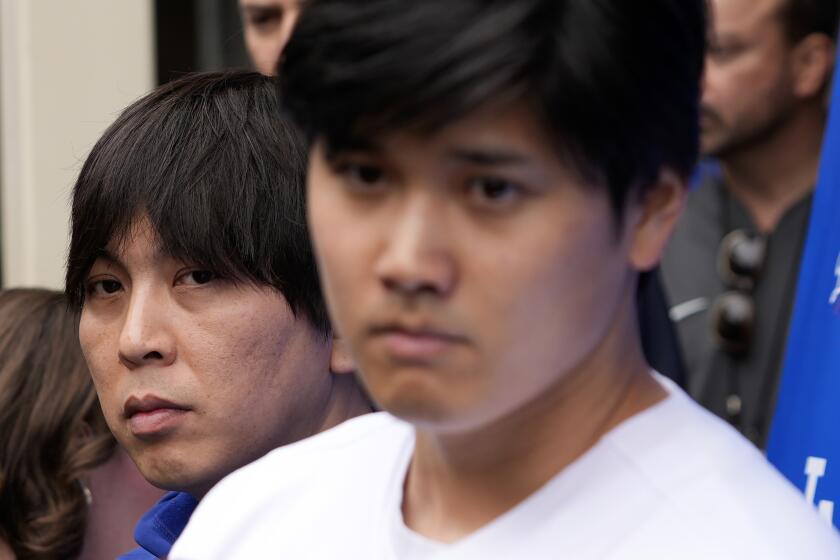Prison Officials Unveil Plan to Halt Gang Fights
State corrections officials said Friday that rival gang members at Corcoran state prison will no longer be forced to mingle in small exercise yards, a practice that has led to a high number of fights and shootings at the troubled facility.
Easing the so-called integration policy comes after criticism of the state Department of Corrections.
Supervisors at the maximum security prison near Fresno called Friday’s announcement a major change that should answer charges that Corcoran guards were baiting rival inmates to fight.
When the security housing unit at Corcoran reopens its recreation yards this week after a monthlong suspension, inmates will have the choice of exercising in a new setting that segregates warring gang members.
Supervisors who have been critical of the integration policy predicted that the modified yard setting would reduce the need for guards to fire wood blocks or 9-millimeter bullets to stop the fights.
“This is a step in the right direction. It’s what we’ve been calling for for the past year,” said one high-ranking officer in the security unit at Corcoran. “Finally, the department has recognized our concerns.”
State corrections officials in Sacramento said it would be a mistake to characterize the change as significant for the 1,300 gang members and other problem inmates who live in the security housing unit, a kind of prison within a prison for the most violent offenders.
Although gang members will now have the option of exercising either alone or in a yard free from known enemies, they will pay a price. Before they can “graduate” from the highly controlled security housing unit, they must prove that they are ready to return to the general prison population by getting along in an integrated yard with potential rivals, the state said Friday.
Those inmates who show no promise of integrating with known enemies will be transferred to the maximum security and geographically isolated Pelican Bay State Prison, where the security housing unit is more restrictive than at Corcoran. Pelican Bay is in Del Norte County on the state’s North Coast.
“In the past, inmates at Corcoran who were disruptive should have been given priority transfers to Pelican Bay and they weren’t,” said Tipton C. Kindel, spokesman for the Department of Corrections. “Look for the traffic between Corcoran and Pelican Bay to definitely increase.”
The policy of mixing rival gang members in small funnel-shaped yards came under scrutiny last summer after The Times detailed allegations of torture, murder and cover-up at the hands of correctional staff at Corcoran.
The integration policy, in part, was blamed for scores of fights between inmates and shootings by guards trying to stop the combatants. Fights also were staged between inmates for the amusement of guards in a ritual known as “gladiator day,” and problem inmates arriving at Corcoran were repeatedly beaten and intimidated, according to former and current prison officials.
Corcoran is home to 5,500 inmates, including Charles Manson and Sirhan Sirhan. Seven inmates--six of them in the security housing unit--have been shot and killed by guards since 1988, the most of any prison in the country in that time span. More than 50 inmates have been wounded.
The 1994 killing of inmate Preston Tate has been the focus of a two-year FBI investigation. Prison officials acknowledge that Tate was shot in error, and a federal grand jury in Fresno is considering criminal indictments. Last month, at the behest of Gov. Pete Wilson, the state attorney general’s office launched its own investigation into allegations of brutality and cover-up at Corcoran.
At the time, Wilson said he was suspending use of the exercise yards at Corcoran’s security housing unit for one month to study the integration policy. The rationale for the policy is that gang members in the security housing unit need to be tested to determine if they can get along before being released to the main yard.
On Friday, outgoing Director of Corrections James H. Gomez said the study showed that the policy was not flawed. The problem, rather, was how supervisors at Corcoran were implementing it.
Instead of providing gang members with the option of exercising in a setting free from rivals, supervisors at Corcoran were forcing them into face-to-face encounters with known enemies. And instead of sending habitual fighters straight to Pelican Bay, supervisors continued to house them at Corcoran.
In the last month, supervisors have undergone retraining to correct these practices, and more than 120 so-called warriors have been sent to Pelican Bay.
“I believe problems in the management of the yards have been identified and corrective actions taken since I suspended yard activity Nov. 22,” Gomez said.
Supervisors overseeing the security housing unit will now evaluate an inmate’s status every month to determine if he has any known enemies and is likely to fight if released to an integrated yard.
More to Read
Start your day right
Sign up for Essential California for news, features and recommendations from the L.A. Times and beyond in your inbox six days a week.
You may occasionally receive promotional content from the Los Angeles Times.






